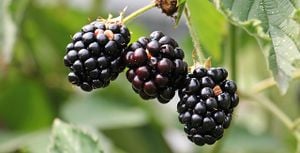m (+image) |
No edit summary |
||
| Line 1: | Line 1: | ||
[[Image:Blackberries01.jpg | [[Image:Blackberries01.jpg|thumb|right|Wild blackberries]] | ||
Blackberries are the fruit of the many ''Rubus'' species grouped together as ''Rubus fruticosus'' species aggregate{{w|Species complex}}, sometimes commonly referred to as "brambles" or "canefruit" (including rasberries). | |||
==Taxonomy== | |||
==Varieties== | |||
==Common names== | |||
==Etymology== | |||
==Range== | |||
==History== | |||
==Morphology== | |||
==Behaviour== | |||
Deciduous shrub.<ref name=crawford2016 /> Growth habit is long and scrambling.<ref name=crawford2016 /> It is perennial but the stems are biennial, fruiting on the second year. | |||
In the wild, it "moves" by putting down new roots where its arching shoots touch the ground.<ref name=crawford2016 /> | |||
==Reproduction== | |||
Self fertile (one plant will fruit by itself).<ref name=crawford2016>Crawford, M (2016). [https://www.worldcat.org/title/creating-a-forest-garden-working-with-nature-to-grow-edible-crops/oclc/1041938577&referer=brief_results Creating a Forest Garden: working with nature to grow edible crops]. Green Books. ISBN 9781900322621.</ref> | |||
==Hardiness== | |||
==Soil Type== | |||
==Soil pH== | |||
==Shade Preference== | |||
Full sun.<ref name=crawford2016 /> | |||
==Shade Tolerance== | |||
Tolerates fairly deep shade (i.e. no direct sun but some indirect light).<ref name=crawford2016 /> | |||
==Aspect== | |||
==Exposure== | |||
==Propagation== | |||
==Maintenance== | |||
The plant can stay healthier and more productive if it is allowed to move.<ref name=crawford2016 /> | |||
==Watering== | |||
==Pruning== | |||
==Problems== | |||
==Harvest== | |||
Fruiting occurs | |||
In Oklahoma, the berries are picked in the weeks following the July 4th weekend. | |||
When harvesting blackberries, watch out for chiggers (also known as berry bugs, see Trombiculidae{{w|Trombiculidae}}). These are small mites that can cause rashes and itchiness when they bite. | |||
When harvesting blackberries, watch out for chiggers (also known as berry bugs). These are small mites that can cause rashes and itchiness when they bite | ==Preservation== | ||
==Uses== | |||
== Uses | |||
Cobblers, Wines | Cobblers, Wines | ||
==Nutritional Values== | |||
==Cooking== | |||
==References== | |||
{{reflist}} | |||
== See also == | == See also == | ||
*[[Berries]] | *[[Berries]] | ||
| Line 17: | Line 49: | ||
[[Category:Food crops]] | [[Category:Food crops]] | ||
[[Category:Berries]] | [[Category:Berries]] | ||
Revision as of 15:27, 23 March 2019

Blackberries are the fruit of the many Rubus species grouped together as Rubus fruticosus species aggregateW, sometimes commonly referred to as "brambles" or "canefruit" (including rasberries).
Taxonomy
Varieties
Common names
Etymology
Range
History
Morphology
Behaviour
Deciduous shrub.[1] Growth habit is long and scrambling.[1] It is perennial but the stems are biennial, fruiting on the second year.
In the wild, it "moves" by putting down new roots where its arching shoots touch the ground.[1]
Reproduction
Self fertile (one plant will fruit by itself).[1]
Hardiness
Soil Type
Soil pH
Shade Preference
Full sun.[1]
Shade Tolerance
Tolerates fairly deep shade (i.e. no direct sun but some indirect light).[1]
Aspect
Exposure
Propagation
Maintenance
The plant can stay healthier and more productive if it is allowed to move.[1]
Watering
Pruning
Problems
Harvest
Fruiting occurs In Oklahoma, the berries are picked in the weeks following the July 4th weekend.
When harvesting blackberries, watch out for chiggers (also known as berry bugs, see TrombiculidaeW). These are small mites that can cause rashes and itchiness when they bite.
Preservation
Uses
Cobblers, Wines